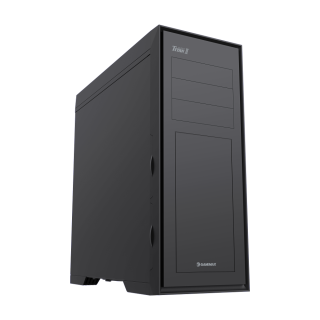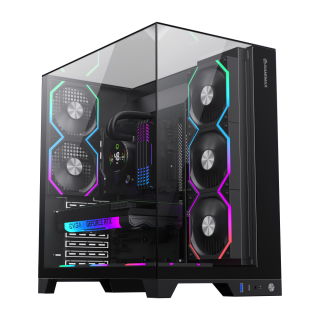When building a PC, the case material significantly impacts not just the aesthetics but also performance, portability, and durability. This comprehensive guide compares three dominant materials—aluminum, tempered glass, and steel—across key metrics like weight, cooling efficiency, aesthetics, and cost, helping you make an informed decision for your next build.

Before diving into specifics, here's a quick comparison of core characteristics:
Property | Aluminum | Tempered Glass | Steel (SECC/SGCC) |
Density | Low (2.7g/cm³) | High (2.5g/cm³, rigid) | Medium (7.85g/cm³) |
Thermal Conductivity | Excellent (205 W/mK) | Poor (1.05 W/mK) | Good (50 W/mK) |
Main Use Cases | Premium/portable cases | Showcases/modular designs | Budget 主流 /industrial cases |
Material Type: Typically 6061 or 5052 aluminum alloy, sometimes with anodized finish for corrosion resistance.
Weight: 30-50% lighter than steel (e.g., Fractal Design Define 7 XL Aluminum weighs 12kg vs 18kg for steel version).
Cooling:
Excellent heat dissipation due to high thermal conductivity, ideal for open-air or semi-open designs.
Often paired with ventilation holes or mesh panels (e.g., Phanteks Enthoo Elite Aluminum Edition).
Aesthetics:
Sleek, minimalist look with brushed or matte finishes; popular in high-end builds (e.g., Apple Mac Pro-inspired designs).
Limited transparency unless combined with glass panels.
Durability:
Resistant to rust but prone to dents (softer than steel).
Anodized coatings improve scratch resistance.
Cost: Premium pricing (\(150-\)400+), 20-30% more expensive than equivalent steel cases.
Pros | Cons |
Lightweight for portability | Higher cost |
Excellent heat dissipation | Susceptible to dents |
Premium aesthetic appeal | Limited color options |
Gamers/enthusiasts who value portability and premium aesthetics.
Builds with high-end components that need efficient passive/air cooling.
Material Type: 4-5mm thick tempered glass (heated to 600°C then cooled rapidly for 5x strength of regular glass).
Weight: Moderate to high (glass panels add 2-3kg to case weight, e.g., Corsair iCUE 4000X Glass weighs 10kg vs 8kg mesh version).
Cooling:
Poor thermal conductivity; relies on case airflow design (front/top mesh panels critical for glass-front cases).
Risk of "闷罐" effect (overheating) in poorly ventilated designs (e.g., full-glass side panels without fan support).
Aesthetics:
90%+ transparency for showcasing RGB-lit components (popular in "showcase" builds like the MSI MPG Gungnir 110R).
Available in clear, smoked, or tinted finishes; some feature curved panels for immersive views (e.g., Jonsbo D31).
Durability:
High impact resistance (withstands 4-5J of energy, vs 0.5J for regular glass) but vulnerable to edge impacts.
Scratch-resistant but fingerprints/show dust prominently.
Cost: Mid to high (\(100-\)300), slightly cheaper than premium aluminum cases.
Pros | Cons |
Stunning visual appeal | Poor inherent cooling |
High scratch resistance | Heavy glass panels |
Showcases RGB components | Risk of edge damage |
Gamers/modders who prioritize aesthetics and component display.
Systems with strong airflow designs (multiple fans/water cooling) to mitigate glass-related thermal issues.
Material Type:
SECC (电解镀锌钢板): Budget-friendly, corrosion-resistant, widely used in mid-range cases (e.g., NZXT H510).
SGCC (热浸镀锌钢板): Thicker, more durable, used in premium steel cases (e.g., Fractal Design Define R6).
Weight: Heaviest of the three (mid-tower steel cases average 8-12kg, e.g., Cooler Master MasterBox TD500 weighs 10kg).
Cooling:
Moderate thermal conductivity; benefits from strategic venting and fan placements.
Often paired with dust filters and sound-dampening materials (ideal for 静音 builds like the Antec P101).
Aesthetics:
Classic, understated look with matte/metallic finishes; less flashy than glass/aluminum.
Some models feature partial glass panels for balance (e.g., Phanteks Eclipse P400S).
Durability:
Highly dent-resistant and sturdy, with galvanized coatings for rust prevention.
Paint finishes may chip over time with rough handling.
Cost: Most affordable (\(50-\)150), offering best price-to-performance ratio.
Pros | Cons |
Budget-friendly | Heaviest material |
Durable and dent-resistant | Basic aesthetics (unless paired with glass) |
Good for sound-dampening builds | Average thermal performance |
Budget-conscious users or those prioritizing durability and functionality.
Quiet builds with soundproofing (steel + 隔音棉 combo, e.g., be quiet! Dark Base Pro 900).
Use this chart to compare materials across key user priorities:
Metric | Aluminum | Tempered Glass | Steel |
Weight | ★★★★★ | ★★★☆☆ | ★★☆☆☆ |
Cooling Potential | ★★★★☆ | ★★☆☆☆ | ★★★☆☆ |
Aesthetics | ★★★★☆ | ★★★★★ | ★★★☆☆ |
Durability | ★★★☆☆ | ★★★★☆ | ★★★★★ |
Cost-Effectiveness | ★★☆☆☆ | ★★★☆☆ | ★★★★★ |
Dust Resistance | ★★★☆☆ | ★★☆☆☆ | ★★★★☆ |
Gaming/Showcase Builds: Opt for tempered glass (for RGB display) + steel/aluminum frame (for structural support), e.g., Lian Li O11 Dynamic EVO.
Portable/HTPC Builds: Lightweight aluminum cases like the Silverstone Milo Series (5L mini-ITX, 2.5kg).
Budget/Quiet Builds: Steel cases with sound-dampening features, e.g., Fractal Design Focus G ($80, SECC steel + dust filters).
If using tempered glass, ensure at least 3x 120mm fans or a 240mm water cooler to maintain airflow.
Aluminum cases benefit from open-air designs (e.g., Raijintek Thetis) for maximum heat dissipation.
Steel cases offer the best longevity for heavy use or frequent hardware swaps.
Tempered glass is ideal for short-to-medium term builds where aesthetics matter most.
Best All-Rounder: Steel cases (versatile, durable, budget-friendly).
Best for Aesthetics: Tempered glass cases (paired with strong cooling solutions).
Best for Premium Builds: Aluminum cases (lightweight, premium feel for high-end setups).
By understanding each material's strengths and trade-offs, you can select a case that not only fits your budget but also enhances your PC's performance and visual appeal. Whether you're a silent computing enthusiast, a RGB-obsessed modder, or a budget-conscious gamer, there's a perfect material waiting for your next build.

Gamemax Titan Silent 2 Full-Tower Gaming PC Case
• Wide Compatibility: Supports EATX, ATX, M-ATX, and ITX motherboards.
• Effective Cooling: Pre-installed front and rear fans, expandable with water cooling support.
• Dust Protection: Top and bottom dust filters to protect internal components.
• Quiet Operation: Built with noise-reducing materials and structure.
• Spacious Interior: Fits 420mm GPUs and 170mm CPU coolers.

Infinity Pro Black Panoramic Tempered Glass Mid-Tower Gaming PC Case
• Full-View DesignThe three sides feature tempered glass panels, allowing clear visibility of the RGB lighting and components inside the case, enhancing the overall aesthetics and creating a cool gaming environment.
• Superior Cooling PerformanceThe case supports up to 8 RGB fan installation positions (including 2x 120mm fans) and can accommodate various water cooling configurations, ensuring the system maintains optimal temperatures under high load, thus enhancing gaming performance.
• Strong CompatibilitySupports ATX, M-ATX, and ITX motherboards, making it suitable for various types of hardware, allowing players to flexibly configure their gaming setups to meet different needs.
• Smart I/O Interface DesignEquipped with multiple USB ports (including USB 3.0 and TYPE-C) for convenient device connections, along with audio support to ensure users enjoy the best sound experience during gaming.
• Excellent ExpandabilityThe case offers multiple internal storage bays, including 1x 3.5-inch hard drive bay and 3x 2.5-inch SSD bays, making it easy for players to expand their storage space to meet the growing demands of gaming.